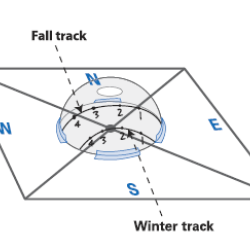Source Institutions
Source Institutions
Add to list Go to activity
Activity link broken? See if it's at the internet archive

In this activity (on page 6 of the PDF), learners plot the path of the sun's apparent movement across the sky on two days, with the second day occurring two or three months after the first. This is an introductory activity in a guide related to the science of sleep and daily rhythms, but can also be used to explain why we have seasons. This activity also has a strong math element as learners will use a protractor to estimate the angle of the sun in a model. This lesson guide includes background information, setup and management tips, extensions and handouts.
- 10 to 30 minutes
- 1 to 7 days
- $1 - $5 per group of students
- Ages 8 - 14
- Activity, Experiment/Lab Activity, Lesson/Lesson Plan, Model, Simulation
- English
Quick Guide
Materials List (per group of students)
- Earth globe (with axial tilt) on a portable stand
- Yellow ball, about 8 in. diameter, to serve as a sun model
- 2 small, blue glass "pony" beads (available from craft stores)
- 2 toothpicks or wooden skewers
- Twine or string, approximately 75 ft
- Glue
- 8-in. squares of cardboard
- 8-in lengths of string
- Clear plastic dome-shaped lids (as used to cover whipped toppings on coffee or frozen drinks)
- Fine-point markers, black
- Pencils
- Protractors
- Rulers
- Several pieces of masking tape
- Copies of student sheets (pp. 10-11)
Subjects
-
Earth and Space Science
- Earth Structure
-
Earth, Moon and Sun
- Days
- Seasons
-
Life Sciences
- Human Body
-
Mathematics
-
Data Analysis and Probability
- Data Analysis
- Data Collection
- Data Representation
-
Geometry
- Plane Geometry
- Solid Geometry
- Measurement
-
Data Analysis and Probability
-
Physical Sciences
-
Motion and Forces
- Rotation Motion
-
Motion and Forces
-
The Nature of Science
-
The Scientific Process
- Conducting Investigations
- Gathering Data
- Formulating Explanations
- Communicating Results
-
The Scientific Process
Informal Categories
- Model Building
Audience
To use this activity, learners need to:
- see
- read
- touch
Learning styles supported:
- Involves teamwork and communication skills
- Involves hands-on or lab activities
Other
Includes alignment to state and/or national standards:
This resource is part of:
Access Rights:
- Free access
By:
- Moreno, Nancy P. ; Tharp, Barbara Z. ; Vogt, Greg L.
Rights:
- All rights reserved, Baylor College of Medicine, 2009
Funding Source:
- NASA, NCC 9-58
